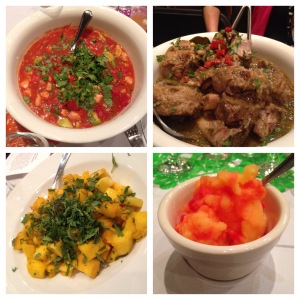Each autumn for the past five years I have spent a glorious weekend in Oxford, and it had nothing to do with football. Attending the annual Southern Foodways Alliance Symposium has become one of my favorite weekends of the year. I save both vacation time and funds to make sure The Wife and I can go. Lots of others do, too, which is why the tickets sold out in three minutes last year. (Shake that off, Taylor Swift.)
I am always amazed by the chefs that cook and the speakers that illumine, and every year it seems I get a better picture of how food permeates everything we do. Each symposium has a theme such as The Global South, Women at Work, The Cultivated South, and of course: Barbecue. Last year, on the fiftieth anniversary of the Civil Rights Act of 1964, we were asked the question, “Who is welcome at the Welcome Table?” Once again I came away not just full of the best efforts of some of the South’s star chefs, but also with an appreciation of food’s interplay with history.
When I think of civil rights, the names that come to my mind right away are Martin Luther King, Jr., Medgar Evers, James Meredith, and Rosa Parks; all justifiably so. But what about Anne Moody and Joan Trumpauer? The Royal Seven or the Greensboro Four? These and many more played a major role in bringing the Civil Rights Act to fruition, and all worked through the avenue of food. Do a little digging on these names and you will find that each of them were involved in sit-ins at segregated restaurants, including the Woolworth’s lunch counter in our own Jackson. Food mattered.
The complete story of how and why restaurants and food played into the civil rights timeline is a fascinating and important one, perhaps better told by others who have done more research than attendance at a weekend symposium. But before I get to the meals, I will share one thing I learned: the plate of civil rights is filled with more than just two dishes, more than just two colors of food, so to speak. In some areas we (in American society) have moved away from the divided plate where foods don’t touch each other, but in others there is still room to learn and to grow. And food still matters.
Our first meal of the weekend was one I was greatly looking forward to. Crook’s Corner restaurant in Chapel Hill, North Carolina is somewhat unique. Since opening in 1982, it has only had two chefs. Bill Neal was the first, and among other accomplishments was the one responsible for establishing it as the birthplace of shrimp and grits. I, for one, am very thankful for shrimp and grits. When that Bill passed away in 1991, he was succeeded by another, Chef Bill Smith, who continues to carry on the legacy of elevating traditional Southern dishes and local ingredients.
I first met Bill Smith at the SFA symposium in 2010. At every meal there are large tables set, and no place cards that tell you where to sit. I didn’t know a soul when I got there, so I met new people every time we ate, and Bill happened to be at one of those tables. At the time, I didn’t know what Crook’s Corner was, and certainly didn’t know that he was a chef. All I knew was that he was on the SFA board of directors, that he could often be spotted wearing a baseball cap, and that he was a genuinely likable guy.
Since then I have seen him at four subsequent meetings, gotten to know him just a little bit better, and have put Crook’s Corner in the upper echelons of my bucket list. But since I rarely get to Chapel Hill, I was pretty excited that Bill and his crew would be feeding us that first night.
The cooks that share the kitchen at Crook’s Corner are from Mexico, and have become an important part of Bill’s life as well as the cuisine that emerges from his kitchen. We were privileged to share in what was called a Nuevo North Carolina Supper, a family meal served family style.
The first dish was Coctel de Camaron, which translates to Shrimp Cocktail, but was really more like shrimp salsa. Imagine a thick tomato-based salsa, plenty with peeled shrimp and chunks of avocado, sprinkled with cilantro, and (I’m pretty sure) spiked with something citrusy. I wouldn’t let the nice lady take it away until I’d eaten seconds. Maybe thirds.
Next on the table were country ham and chile tamales. When I read this on the menu, I expected chunks of ham in the masa, but alas, they were not there. Upon further study of the menu I learned that it was broth from drippings of country ham baked in Coca-Cola that had moistened the masa. Lots of cultures mingling here, and the result was a tasty tamale.
The main course was Pork Shanks Braised with Hominy and Corn. There was all sorts of good stuff floating around in this bowl, after the shanks had been braised with tomatillos for several hours. Following that was a simple mango salad – chunks of mango, lime juice and lots of cayenne pepper. To cool the tongue we got a tub of orange juice sorbet studded with Red Hots. Yes, that’s Red Hots, the candy. In sorbet. I dipped my share and more out of that tub, and I could use a bowlful right now if you don’t mind.
I saw Bill the next day and told him the meal was not just fabulous food – it was also fun. He replied that he was glad to hear it and added: “I’m tired of serious dinners.” If non-serious dinners mean eating food like that again, I’m with him.


